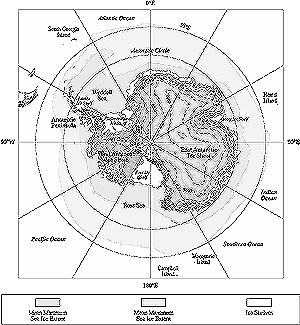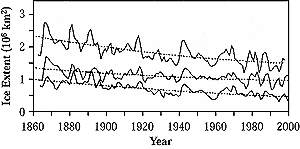16.1.3.1. The Arctic
|

Figure 16-2: Location map for the Antarctic. Elevations
on Antarctic continent are indicated by dashed contour lines (500-m interval).
Topography and ice shelf outlines are from U.S. Geological Survey and
British Antarctic Survey data. Sea-ice extent data are from Couper (1989).
|

Figure 16-3: Time series of April sea-ice extent in Nordic Sea (1864-1998)
given by 2-year running mean and second-order polynomial curves. Top: Nordic
Sea; middle: eastern area; bottom: western area (after Vinje, 2000). |
Instrumental observations of climatic parameters over
the 20th century are available from standard climate stations on land and measurements
taken on drifting ice floes in the Arctic Ocean. The land stations show that
warming in the Arctic, as indicated by daily maximum and minimum temperatures,
has been as great as in any other part of the world. Although not geographically
uniform, the magnitude of the warming is about 5°C per century, with areas
of cooling in eastern Canada, the north Atlantic, and Greenland (Koerner and
Lundgaard, 1996; Borzenkova, 1999a,b; Jones et al., 1999; Serreze et al., 2000).
Data from ice floe measurements show a slight warming on an annual basis, with
statistically significant warming in May and June over the 1961-1990 period.
Air temperature anomalies in the Arctic basin have been strongly positive since
1993. In the period 1987-1997, air temperature in the Arctic increased
by 0.9°C (Alexandrov and Maistrova, 1998).
Significant warming from the beginning of the 20th century has been confirmed
by many different proxy measurements (Maslanik et al., 1996; Bjorgo et al.,
1997; Smith, 1998). Magnuson et al. (2000) found consistent evidence of later
freeze-up (5.8 days per 100 years) and earlier breakup (6.5 days per 100 years)
of ice on lakes and rivers around the northern hemisphere from 1846 to 1995
and an increase since 1950 in interannual variability of both dates. Glaciers
and ice caps in the Arctic also have shown retreat in low-lying areas since
about 1920. Numerous small, low-altitude glaciers and perennial snow patches
have disappeared. However, no increasing melting trend has been observed during
the past 40 years (Jania and Hagen, 1996; Koerner and Lundegaard, 1996; Dowdeswell
et al., 1997). Glaciers in Alaska have receded, with typical ice-thickness decreases
of 10 m over the past 40 years, but some glaciers have thickened in their upper
regions (BESIS, 1997). Greenland's ice sheet has thinned dramatically around
its southern and eastern margins. Above 2,000-m elevation, the ice sheet is
in balance, on average. The net effect is a loss of about 51 km3
yr-1. (Krabill et al., 1999, 2000).
Snow-cover extent in the northern hemisphere has been reduced since 1972 by
about 10%, largely as a result of spring and summer deficits since the mid-1980s
(Brown, 2000; Serreze et al., 2000). Most Arctic regions have experienced increases
in precipitation since at least the 1950s (Groisman et al., 1991; Groisman and
Easterling, 1994; Georgiyevskii, 1998). Measurements from Spitsbergen show a
statistically significant increase in precipitation during all seasons, except
winter (Hanssen-Bauer and Forland, 1998).
Groisman et al. (1994) analyzed seasonal snow extent in the northern hemisphere
and demonstrated an inverse relationship with near-surface air temperature.
Recent findings have provided evidence of a significant decrease in spring snow
extent since 1915 over Eurasia (Brown, 1997) and southern Canada (Brown and
Goodison, 1996). Such trends may be related to low-frequency fluctuations in
hemispheric atmospheric circulation patterns (Serreze et al., 2000).
Arctic sea-ice extent decreased by approximately 3% per decade between 1978
and 1996 (Cavalieri et al., 1997; Parkinson et al., 1999; Johannessen
et al., 1999; Serreze et al., 2000). The most significant contractions
were detected in 1990, 1993, and 1995 (Maslanik et al., 1996). Ice composition
also has changed, with a reduction in the area of multi-year ice in winter.
Summer sea-ice extent has shrunk by 20% (880,000 km2) over the past
30 years in the Atlantic part of the Arctic Ocean (Johannessen et al.,
1999), but the shrinkage has only been 5% in the Canadian Arctic Sea. Sea-ice
extent in the Bering Sea experienced a dramatic reduction when a regime shift
occurred in 1976 and has continued to decrease (BESIS, 1997). New compilations
of Arctic sea-ice extent, using historical data from the past 135 years (Vinje,
2001), show that overall sea-ice extent in April has been reduced in the Nordic
seas by 0.79 x 106 km2 (33%) (see Figure 16-3).
Nearly half of this reduction took place between 1860 and 1900. Although there
are large interannual and seasonal variations in sea-ice extent, the reduction
is greatest in spring. This is consistent with the 1912-1996 temperature record
from Svalbard, which shows significant warming (3°C) in spring (Hanssen-Bauer
and Forland, 1998). There is an approximate 10-year climate signal in the Arctic
and subarctic, with a clockwise propagating signal in sea-ice concentration
anomalies and a standing oscillation in sea-level pressure anomalies—the
latter linked to the two phases of the North Atlantic Oscillation (NAO) (Mysak
and Venegas, 1998). Comparison of these trends with outputs from climate models
(forced by observed GHGs and tropospheric sulfate aerosols) reveals that the
observed decrease in northern hemisphere sea-ice extent agrees with transient
simulations (see Figure 16-6) and that both trends
are much larger than would be expected from natural climate variations (Vinnikov
et al., 1999).
The most effective method for determining the thickness of sea ice is to use
sonar, directed upward at the floating ice from submarines or moorings (Melling
et al., 1995). The results indicate great variability. Average thinning of sea
ice has been observed since 1976 on some transects of the Atlantic and Arctic
Oceans (Wadhams, 1997). A thinning by about 0.13 m over the period 1970-1992,with
the maximum decrease detected in the eastern Siberian Sea, was found by Russian
scientists (Nagurduy, 1995). Rothrock et al. (1999) found that ice draft at
the end of the melt season has decreased by about 1.3 m in most of the deepwater
portion of the Arctic Ocean, from 3.1 m in 1958-1976 to 1.8 m in the 1990s
(~15% per decade). The decrease is greater in the central and eastern Arctic
than in the Beaufort and Chukchi seas (Rothrock et al., 1999). Vinje et al.
(1998), however, claim that no significant change in ice thickness can be observed
in Fram Strait. Their conclusion is in agreement with submarine observations
from 1960-1982. Although there is large variability, ice cover has continued
to become thinner and has decreased by 40% over the past 3 decades (Rothrock
et al., 1999). Analysis of the duration of summer melt over a large fraction
of the perennial Arctic sea ice from 1979 to 1996 reveals an increase of 5.3
days (8%) per decade in the number of melt days each summer (Smith, 1998).
Continues on next page
|